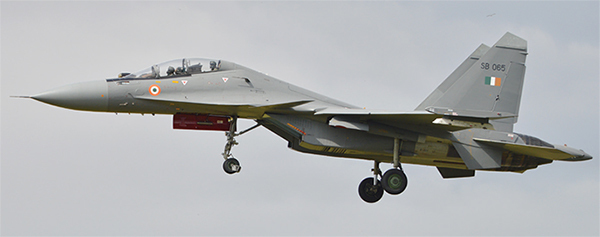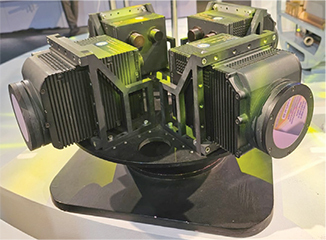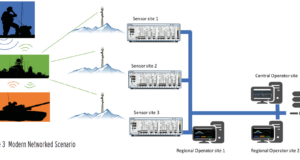Airborne Insight – New Radars and EW Systems for the Indian Air Force

By Atul Chandra
THE INDIAN AIR Force’s (IAF) primacy as the Indian Government’s instrument of choice to respond in anger against threats to national sovereignty has once again been demonstrated during recent combat actions against Pakistan in May. This is an important transition for a nation that has historically turned to the Indian Army to guarantee territorial sovereignty and deter adversaries. Prime Minister Narendra Modi’s preference for the air force as an instrument of deterrence is borne from its transformation into a potent instrument for force projection and deterrence, strengthened by several important acquisitions over the past decade.
The IAF’s strengths were on display during combat actions it undertook this May as part of Operation Sindoor, when it struck deep into Pakistan destroying state-supported terrorist infrastructure and significantly damaging military infrastructure and airbases, eroding the combat capability of the Pakistan Air Force (PAF). The IAF attacked Pakistani targets using long-range precision weapons, loitering munitions and cruise missiles of both foreign and domestic origin, which penetrated an extensive PAF air-defense network on successive occasions, between May 7-10. Interestingly, India’s Ministry of Information & Broadcasting later announced that the IAF had bypassed and jammed Pakistan’s Chinese-supplied air defense systems, completing the mission on May 7 in just 23 minutes. This statement appeared to target the performance of Pakistan’s HQ-9 and HQ-16 Surface-to-Air Missile (SAM) systems, which are of Chinese origin.

Both sides also engaged in unprecedented large scale air battles using Beyond Visual Range Air-to-Air Missiles (BVRAAM), with losses claimed on either side, but which neither government have officially confirmed. However, India’s Chief of Defence Staff, General Anil Chauhan, in interviews to Reuters and Bloomberg, on the sidelines of the IISS Shangri-La Dialogue held in Singapore in May, accepted that losses were suffered by the IAF during initial combat actions on May 7.
The recent combat operations by both sides also featured use of critical combat enablers, such as Airborne Early Warning aircraft, in-flight refueling aircraft and electronic intelligence (ELINT) and surveillance platforms, which provided better battlefield awareness and enhanced mission effectiveness on both sides. India and Pakistan are investing heavily in airborne early warning and special mission platforms. The PAF has invested in acquiring and operating a sizeable AEW&C fleet estimated now at nine Saab Erieye Airborne Early Warning & Control (AEW&C) aircraft, along with four Chinese ZDK03 Karakoram Eagle Airborne Warning and Control System (AWACS) aircraft, with the latter thought to have transitioned into an EW role. These aircraft are which are deeply integrated into the PAF’s ground-based command and control network. These assets appear to have been used to great effect by the PAF in its recent skirmishes with the IAF, helping to deter the latter from entering into Pakistan’s airspace.

Tasked with the objective of maintaining the qualitative status with respect to its largest neighbors (Pakistan and China), the IAF has arguably had a tougher task of modernizing its forces, focused instead on halting the decline in its combat fleet and upgrading its air defense network and Ballistic Missile Defence (BMD) capability. The IAF has, over the years, upgraded its legacy fighter fleets bringing them to a near 4th-Gen capability, buts its aging Sepecat Jaguar strike aircraft and MiG-21 Bison fleets are increasingly difficult to sustain. Importantly for the IAF, its air defense network comprising the Russian S-400 Triumpf, Indo-Israeli Medium Range SAM (MR SAM), Israeli Spyder SAM and indigenously developed Akash SAM, along with legacy Russian-origin SAM systems such as the SA-3 Pechora and OSA-AK-M (SA-8 Gecko) performed exceedingly in Operation Sindoor, according to the Indian Ministry of Defence (MOD).
There have been concerns as to whether the IAF has invested sufficiently in inducting the required numbers of airborne intelligence assets and EW systems needed. In a discussion with JED on EW capability in the air force, Air Marshal M Matheswaran AVSM VM PhD (Retd.), who retired as Deputy Chief of Integrated Defence Staff (DCIDS-Policy, Plans, & Force Development) at HQ IDS – Tri Services Command and is the founder of The Peninsular Foundation, a think tank, said, “When speaking about ideal requirements, there will always be a shortfall because of various factors: funding, economics, development challenges and all those issues. But from an operational perspective, is at least the minimum required available to us for our operational requirements? Yes, I would say it is.”

Airborne Assets
The IAF has significantly enhanced its Airborne Early Warning, ELINT and communications intelligence (COMINT) capability, all of which played a significant role in its recent operations. The air force presently operates three Beriev A-50 Phalcon AWACS platforms, along with two indigenously developed DRDO Netra AEW&C aircraft. As per the air force, some of the major acquisitions/upgrades (much of it indigenous) across different platforms planned for 2025-2026 and slated for completion by March 2026 include low level radars, EW suites for helicopters, improved chaff and flare rounds, new airborne jammers, SIGINT and communications jamming aircraft, AEW&C systems, and several other types of radars. In December 2024, the Indian MOD announced that production of Magnesium Teflon Viton (MTV) flares currently used in IAF aircraft had been indigenized with the help of the High Energy Material Research Laboratory, with ground trials successfully completed. It is expected that the new flares will be introduced fleetwide.
A report by India’s Standing Committee on Defence, presented to the Indian Parliament in March 2024, quoted an air force official who stated that the IAF’s present inventory of airborne early warning aircraft largely consists of the limited number of legacy AWACS and three indigenously developed Netra aircraft. “The IAF has already initiated two programs of six AEW aircraft each and one for a special role aircraft,” said the report. “All these projects will have indigenous mission systems and the nodal agencies for these programs are the Defence Research & Development Organisation (DRDO) and the Centre for Airborne Systems (CABS).”

The air force is processing a case for the design and development of six AEW&C Mk-1A aircraft to help bridge its AEW&C capability gap. These six aircraft can be considered as a follow-on version of the Netra AEW&C, with substantial improvements. In September 2021, India’s Apex Cabinet Committee on Security (CCS), which is headed by Prime Minister Narendra Modi, approved the procurement of six AEW&C Mk-II aircraft, which are expected to offer significantly improved performance, range and endurance as compared to the AEW&C Mk-1A. It will feature an enhanced radar for better range, upgraded Mission System Avionics (MSA) and a new EW and sensor fit.
The air force has opted to acquire pre-owned Airbus A321 aircraft from Air India, which will be modified by DRDO in conjunction with selected system integrators. The MOD revealed in December 2023 that the air force had already begun operating the A321s it had acquired, even as it awaited modifications to be undertaken by the DRDO. Four aircraft are being used by the IAF for transport and courier duties, while two aircraft have been transferred to the DRDO for AWACS modification. The AEW&C Mk-II is a reboot of the AWACS India program approved by the MOD in February 2013 and is slated to be completed within seven years. The AWACS India program was to be based on an Airbus A330 platform, with six to be acquired initially and options for four more.
The air force is also eyeing the procurement of three SIGINT and communications jamming aircraft. In February 2024, the air force had issued a Request for Information (RFI) for three intelligence, surveillance, targeting and reconnaissance (ISTAR) platforms, and it is eyeing pre-owned business jet platforms for this program. The required sensors and mission systems will be installed domestically. As per the RFI, the main purpose of the ISTAR platform is to provide accurate actionable intelligence acquired through Synthetic Aperture Radar (SAR) and Electro Optical/Infra-Red (EO/IR) sensors and disseminate the information via SATCOM, Wideband Line of Sight (LoS) and Operational Data Links (ODLs). The RFI calls for all three ISTAR platforms to be delivered within 60 months of contract signature. The Acceptance of Necessity (AoN), which marks the formal commencement of the Indian procurement process, was accorded by the Defence Acquisition Council (DAC) in March 2024. The Request for Proposal (RFP) was issued to selected firms in September 2024.

Integrated Air Command and Control System
India’s indigenously developed Integrated Air Command and Control System (IACCS) is now largely operational across all operational commands of the air force, including Andaman Nicobar Command (ANC). The entire monitoring and command and control of the air situation is achieved through the IACCS, which is a seamless network of all ground and airborne sensors in the country. The IACCS is unique in its design and provides the required redundancy and flexibility in the command and control of Indian airspace.
As per information provided by India’s MOD in December 2024, it was planned that all national air surveillance radars would be integrated to achieve a fused air picture at IACCS. It stated that integration of all IAF and civil radars had been completed. The integration of the nationwide network of Indian Army air defense sensors is planned through Project Akashteer and integration of Indian Naval ships based sensors is planned through Project Trigun, for which the first site integration is under progress. Naval sensors located on India’s mainland and island territories are also being integrated directly to enhance surveillance in island territories.
Prized Capability
India’s airborne command and control ambitions have a long history, stemming from the formation of the Airborne Surveillance, Warning and Control (ASWAC) center in 1985, to study the feasibility of developing an indigenous AWACS. This eventually led to the creation of CABS in 1991, located in Bengaluru. CABS was given the task of designing and developing AWACS systems for the IAF, and it converted an HS-748 transport on loan from the air force into an airborne surveillance platform (ASP) fitted with a rotating radome. However, the program ended in tragedy in 1998 when the sole prototype crashed while undertaking a test flight at INS Rajali at Arakkonam in southern India. Continuing its work, CABS submitted a proposal for development of an indigenous AEW&C, which was approved by the Government in August 2004. Three AEW&C aircraft, featuring Active Electronically Scanned Antenna (AESA)-based primary radars, Identification Friend or Foe (IFF) systems, and ELINT and COMINT systems, would be hosted on Embraer-145 executive jets.
In the meantime, the IAF continued in its search for AWACS capability, which eventually resulted in a US$1.1 billion order placed in 2004 for three Beriev A-50 AWACS fitted with Israeli radars. The first aircraft was inducted into service in May 2009, with No.50 Sqn at Palam Air Force Station. The Beriev A-50 is based on a Russian Ilyushin IL-76 and fitted with PS-90A-76 engines and the ELTA EL/M-2075 Phalcon radar system. All three aircraft were inducted into the IAF between May 2009 and March 2011. India’s IL-76/IL-78 have been plagued by low serviceability, however, with the A-50 AWACS fleet demonstrating serviceability rates of approximately 66 % in its first five years of operational service. Air Force plans to augment its A-50 fleet with two more platforms never came to fruition.

CABS originally planned to deliver three AEW&Cs to the air force by 2011 under a US$350 million effort. However, it was only in February 2017 that the first indigenous Netra AEW&C platform achieved Initial Operational Capability (IOC). The second aircraft was delivered to the air force in September 2019, with CABS retaining the third for developmental flight testing. Despite its long development schedule, the multi-sensor state-of-the-art AEW&C aircraft is an integral part of IAF operations and is used extensively for target acquisition and surveillance. Its primary sensor is an AESA radar, in addition to incorporating an IFF system, radar electronic support measures (RESM), communications ESM (CESM), line-of-sight and SATCOM data links, etc.
The Netra’s AESA radar was the first of its kind to be developed indigenously in India. Its transmit/receive modules were also designed and developed by DRDO and manufactured by a local industry partner. The Active Antenna Array Unit (AAAU), measuring 8.2 x 0.9 x 0.5 meters and mounted along the topside of the aircraft fuselage, was also developed domestically. The Netra AEW&C platform has five operator workstations, each of which is software reconfigurable to operate in one of six modes: Air Situation Picture/Command & Control (ASP/C2); ASP/C2 and CESM; ASP/C2 and RESM; Global Air Situation Picture (GASP) Reconstruction & Playback; and Image & Voice Playback.
New Airborne Radar and EW Capabilities for IAF Fighters
There is a considerable amount of work going on in India towards the development of domestic airborne radars, jammers and EW systems. Some of these were showcased at the Aero India airshow held in February. The DRDO’s Instruments Research & Development Establishment (IRDE) located in Dehradun is developing infrared search and track (IRST) systems and missile approach warning systems (MAWS) for use on the upcoming LCA Mk2 and the future Advanced Medium Combat Aircraft (AMCA), in addition to other platforms. The domestically developed IRST is claimed by IRDE to be capable of long-range point target detection up to 100 km. The system is based on a passive IR sensor capable of performing automatic search, detection and tracking of multiple airborne threats at long ranges in wide scan volume. The IRST will compute the target track parameters via angles and communicate it to the aircraft’s mission computer for cueing missiles or communicating to wingmen.
IRDE is also developing a new MAWS for fighter aircraft, as well as larger platforms, such as AWACS and AEW&C. Configured as a multiple Line Replaceable Unit (LRU) system, the MAWS will provide spherical coverage around the aircraft for autonomous detection, tracking and automatic cue generation for approaching missiles. It features multiple dual-band sensors (presently imported from Israel) which provide 360-degree coverage and performs automatic cueing of countermeasures.

The IAF’s SU-30 MKIs will also receive a new Long Range Dual Band Infrared Imaging Search and Track System (IRST) to replace its obsolete Russian-origin Optical Locator Sensor (OLS), which suffers from reliability and maintainability problems. In April 2022, state-owned airframer Hindustan Aeronautics (HAL) entered into a contract with Bharat Electronics (BEL) for co-development and co-production of this new IRST. At least 100 systems will be procured. The IRST comprises a television day camera, infrared and laser sensors and will be able to operate in day and night conditions for air-to-air and air-to-ground target tracking and localization.
Also on display at Aero India were 1:2 scale models of the Uttam AESA radar being developed for the Tejas Mk-1A and the Virupaksha AESA radar for the Sukhoi Su-30 MKI. What is most interesting about Indian efforts in radar and EW is that it now has the capability to develop, integrate, test and certify the entire radar and EW backbone for not only indigenous platforms such as Tejas, LCA Mk2 and AMCA, but also such foreign types such as the SU-30 MKI and Sepecat Jaguar.
Speaking to JED at Aero India, BN Lokesh, Scientist G, Project Director for the LCA Mk-1A EW program, said over 120 test sorties had been flown with a prototype Uttam radar integrated on LCA test aircraft LSP 2 and LSP 3. These aircraft were also used to test the indigenously developed EW suite, with over 30 flights to date. Lokesh stated that evaluation of the Uttam radars during flight trials had shown better performance than the ELTA ELM-2052 AESA radar. The Uttam radar was slated to be cleared by the Centre for Military Airworthiness & Certification (CEMILAC) this year. Present plans call for the ELM-2052 radars on Tejas Mk-1A aircraft to be replaced with Uttam radars from the 41st production aircraft, which could likely happen by 2028-29.
Indian efforts to replace the NIIP N011M Bars radars on a substantial portion of its Su-30 MKI fleet with the Virupaksha AESA radar is a milestone effort that has not been attempted anywhere else. The detection range of the legacy Russian radar system is pegged at approximately 80 km for a fighter class target, whereas the new Indian radar will offer detection ranges in excess of 200 km. Development of the Virupaksha radar, which is based on the Uttam radar, commenced in 2023, and flight trials on a Su-30 MKI aircraft are slated for 2026-27. This radar also will use an indigenously developed mission computer, radar computer and display processor.
Another recent development in the Su-30 MKI program is the upcoming flight trials with new indigenously developed Airborne Self Protection Jammer (ASPJ) pods. The aircraft’s current Russian-origin SAP-518 EW pods weighs 450 kg. They not only impose significant maneuver restrictions but are also facing serviceability issues. The DRDO-developed ASPJ weighs only 150 kg and offers far greater threat detection and jamming range and provide 360 degree coverage. Integration of the domestically developed ASPJ on an IAF Su-30 MKI test aircraft is slated for 2026. Trial production of Dhruti DR-118 digital radar warning receivers (RWRs) for Indian Su-30 MKIs is also underway. The trio of these systems will ensure that the radar and EW fit on the approximately 84 Su-30 MKIs planned to be upgraded will be fully of Indian origin.

In the Balance
Slowly but surely India is moving ahead with its developments of indigenous AEW&Cs, AESA radars and EW technology, in what is an unprecedented success for a nation that has drifted away from its traditional reliance on Russian military hardware and chosen instead to depend on its largely state-owned defense research establishments and industry. While largely hidden away from view, some of the successes in this arena are slowly emerging as a result of combat actions with India’s old adversary, Pakistan.
IAF actions in May, relied on the sophisticated integration of its AWACS/AEW&C assets with its nationwide IACCS network. This in turn aided in the protection of vital airfields against missile, rocket and drone attacks using a layered air defense system – which also featured several domestically developed systems. It is critical that the indigenous AEW&C Mk-1A and AEW&C Mk-II platforms are inducted into service before the end of the decade.
The true test, however, for Indian EW and radar ambitions will be the timely completion of development of the various systems for the IAF’s various fighter programs, such as the Tejas Mk-1A, LCA Mk2, AMCA and Su-30 MKI. Cumulatively, these programs alone will encompass nearly 600 fighter class platforms and at least a dozen airborne early warning aircraft – a significant portion of the IAF fleet. Indigenous technology development is at the heart of these programs, and India will continue to build on this success in the decades to come.




